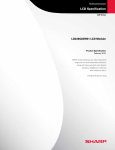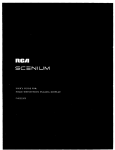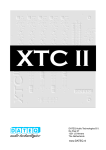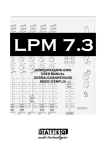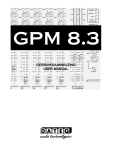Download Sharp R-332 Specifications
Transcript
LM10V332 Color STN LCD Module (Model Number: LM10V332) Specifications Spec No.: LC99213A Dated: May 31. 2002 NOTICE This publication is the proprietary of SHARP and is copyrighted, with all rights reserved. Under the copyright laws, no part of this publication may be reproduced or transmitted in any form or by any means, electronic or mechanical for any purpose, in whole or in part, without the express written permission of SHARP. Express written permission is also required before any use of this publication may be made by a third party. The application circuit examples in this publication are provided to explain the representative applications of SHARP's devices and are not intended to guarantee any circuit design or permit any industrial property right or other rights to be executed. SHARP takes no responsibility for any problems related to any industrial property right or a third party resulting from the use of SHARP's devices, except for those resulting directly from device manufacturing processes. In the absence of confirmation by device specification sheets, SHARP takes no responsibility for any defects that occur in equipment using any of SHARP's devices, shown in catalogs, data books, etc. Contact SHARP in order to obtain the latest device specification sheets before using any SHARP's device. SHARP reserves the right to make changes in the specifications, characteristics, data, materials, structures and other contents described herein at any time without notice in order to improve design or reliability. Contact SHARP in order to obtain the latest specification sheets before using any SHARP's device. Manufacturing locations are also subject to change without notice. Observe the following points when using any device in this publication. SHARP takes no responsibility for damage caused by improper use of the devices. The devices in this publication are designed for use in general electronic equipment designs, such as: ・Automotive auxiliary information display ・Automotive audio visual equipment The appropriate design measures should be taken to ensure reliability and safety when SHARP's devices are used for equipment such as: ・Transportation control and safety equipment(i.e., aircraft, trains, automobiles, etc.) ・Traffic signals ・Gas leakage sensor breakers ・Alarm equipment ・Various safety devices etc. SHARP's devices shall not be used for equipment that requires extremely high level of reliability, such as: ・Military and space applications ・Nuclear power control equipment ・Medical equipment for life support Contact a SHARP representative, in advance, when intending to use SHARP's devices for any "specific" applications other than those recommended by SHARP. Contact and consult with a SHARP representative if there are any questions about the contents of this publication. RECORDS OF REVISION DATE JUL.12.1999 REF.PAGE PARAGRAPH DRAWING No. P5,P6 REVISED SUMMARY NO. 1 P5 /Table5 P10 /Table7 P16 /Fig7 P21 /Fig11 P25 1 1 Ambient temperature Supply current, Power comsumption, Rush current Data set up time 1 1 1 VDD on/off cycle, Regulation “d”,”g”,”h” Applicable inspection standard DOC.FIRST ISSUE FEB.17.1999 CHECK AND APPROVAL SPEC No. MODEL No. LC99213A Contents LM10V332 Page 1.Application 2 2.Construction and Outline 2 3.Mechanical Specifications 3 4.Absolute Maximum Ratings 3 4-1.Electrical absolute maximum ratings 3 4-2.Enviroment Conditions 4 5.Electrical Specifications 5 5-1.Electrical characteristics 5 5-2.Interface signals 6 6.Module Driving Method 12 6-1.Circuit configuration 12 6-2.Display face configuration 12 6-3.Input data and control signal 12 7.Optical Characteristics 14 8.Characteristics of Backlight 19 9.Supply voltage sequence condition 21 10.Cautions 22 11.Applicable inspection standard 25 Warning 25 PAGE 1 SPEC No. LC99213A PAGE MODEL No. LM10V332 2 1. Application This data sheet is to introduce the specification of LM10V332, Passive Matrix type Color LCD module. 2. Construction and Outline Construction: 640×480 dots color display module consisting of an LCD panel, PWB(printed wiring board) with electric components mounted onto, TCP(tape carrier package) to connect the LCD panel and PWB electrically, and plastic chassis with CCFT back light and bezel to fix them mechanically. Signal ground(Vss) is connected with the metal bezel. DC/DC converter is built in. PW B TCP L C D panel B ezel (w ith A n ti -g la re tre a tm e n t, P e n c il h a rd n e s s 3 H ) P la s tic c h a s s is Outline :See Fig. 13 Connection :See Fig. 13 and Table 6 L ig h t P ip e CCFT B ezel SPEC No. PAGE MODEL No. LC99213A LM10V332 3. Mechanical Specification Table1 Parameter Outline dimensions Specifications Unit 264±0.5(W)×193.6±0.5(H)×8.5MAX(D) Mm Bezel opening area 215.2±0.3(W)×162.4±0.3(H) mm Display format 640(W)×480(H) full dots mm Dot size 0.09×RGB(W)×0.31(H) - Dot spacing 0.02 mm Normally black *2 - Approx. 450 g *1 Base color Weight *1 Due to the characteristics of the LC material, the colors vary with environmental temperature. *2 Negative-type display Display data “H” : ON Display data “L” : OFF → transmission → light isolation 4.Absolute Maximum Ratings 4-1.Electrical absolute maximum ratings Table 2 Parameter Symbol MIN. MAX. Unit Remark Supply voltage(Logic) VDD-VSS 0 6.0 V Ta=25 ℃ Input voltage VIN -0.3 VDD+0.3 V Ta=25 ℃ 3 SPEC No. PAGE MODEL No. LC99213A LM10V332 4 4-2.Environment Conditions Table 3 Tstg Item Ambient temperature Topr MIN. MAX. MIN. -25 ℃ +60 ℃ 0 ℃ Remark MAX. 1 +50 ℃ +40℃ Note 4) Humidity Note 1) Note 1) No condensation Vibration Note 2) Note 2) 3 directions(X/Y/Z) Shock Note 3) Note 3) 6 directions(±X±Y±Z) Note 1) Ta≦40 ℃ Ta>40 ℃ 95 % RH Max. Absolute humidity shall be less than Ta=40 ℃/95 % RH. Note 2) Table 4 Frequency 10 Hz~57 Hz 57 Hz~500 Hz Vibration level - 9.8 m/s2 Vibration width 0.075 mm - 10 Hz~500 Hz~10 Hz/11.0 min Interval 2 hours for each direction of X/Y/Z (6 hours as total) Note 3) Acceleration Pulse width : 490 m/s2 : 11 ms 3 times for each directions of ±X/±Y/±Z Note 4) As opt-electrical characteristics of LCD will be changed, dependent on the temperature, the confirmation of display quality and characteristics has to be done after temperature is set at 25℃ and it becomes stable. SPEC No. PAGE MODEL No. LC99213A LM10V332 5 5.Electrical Specifications 5-1. Electrical charasteristics Table 5 Parameter Symbol Supply voltage (Logic) VDD-VSS Ta=25 ℃ Conditions 1 VDD= 5.0 V±10 % Min. Typ. Max. Unit 4.5 5.0 5.5 V 0.8 1.95 2.8 V 0.8VDD - VDD V - 210 90 1 1050 450 0.2VDD 1 320 135 1 1600 680 1 2A×2 1A×2 1 1A×10 0.5A×20 V Ta = 0~50 40℃(Note 1) Contrast adjust voltage Vcon -VSS Input signal voltage VIN 1 Ta = 0~40 ℃ “H” level 1 “L” level Ta = 0~ 50 40℃ 0 1 Supply current(Logic) IDD Note 2) - Power comsumption Pd Note 2) - IDD Ta=25℃,Note 1)-① - - Ta=25℃,Note 1)-② - - Rush current(Logic) mA mW ms μs Note 1) Under the following conditions.;Logic voltage(VDD) should be designed to supply following Inrush current. ①Immediately after the rise of VDD . ②Under the situation that DISP signal is on and kept steady. Measurement Circuit: TMD-18-3 VDD (VDD Power Supply)(TAKASAGO) YD etc A: DISP IDD 2A 1AMAX B: 2 ms MAX B A 1 D C C: D: 1 1A 0.5AMAX 1 10 μs 20μs MAX Note 2) Under the following condetions Vcon-Vss: contrast max.(1.95V typ.) VDD-VSS=5V,Frame frequency=120Hz, Display pattern : black/white stripe pattern. □□□□□□□□□□□□□□□□□□□□ ■■■■■■■■■■■■■■■■■■■■ □□□□□□□□□□□□□□□□□□□□ ■■■■■■■■■■■■■■■■■■■■ This value Is direct current. SPEC No. LC99213A PAGE MODEL No. LM10V332 5-2.Interface signals LCD Pin No. 1 2 3 4 5 6 7 8 9 10 11 12 13 14 15 16 17 18 19 20 21 22 23 24 25 26 27 28 29 30 31 Symbol DL4 VSS DL5 YD DL6 LP DL7 VSS VSS XCK DL0 Vcon DL1 VDD VSS VDD DL2 DISP DL3 NC VSS DU3 DU4 DU2 DU5 DU1 VSS DU0 DU6 VSS DU7 Table 6 Description Display data signal Ground potential Display data signal Scan start-up signal Display data signal Input data latch signal Display data signal Ground potential Ground potential Data input clock signal Display data signal Contrast adjust voltage Display data signal Power supply for logic and LCD Ground potential Power supply for logic and LCD Display data signal Display control signal Display data signal Ground potential Display data signal Display data signal Display data signal Display data signal Display data signal Ground potential Display data signal Display data signal Ground potential Display data signal Level H(ON), L(OFF) H(ON), L(OFF) “H” H(ON), L(OFF) “H” → “L” H(ON), L(OFF) “H” → “L” H(ON), L(OFF) H(ON), L(OFF) H(ON), L(OFF) H(ON), L(OFF) H(ON), L(OFF) H(ON), L(OFF) H(ON), L(OFF) H(ON), L(OFF) H(ON), L(OFF) H(ON), L(OFF) H(ON), L(OFF) H(ON), L(OFF) H(ON), L(OFF) 6 SPEC No. PAGE MODEL No. LC99213A LM10V332 CCFT Pin No Symbol Description Level 1 HV High voltage line (from Inverter) - 2 NC NC - 3 GND Ground line (from Inverter) - LCD Used connector : DF9B-31P-1V(HIROSE) Mating connector : DF9B-31S-1V(HIROSE) CCFT Used connector : BHR-03VS-1(JST) Mating connector : SM02(8.0)B-BHS(JST) Except above connector shall be out of guaranty. 7 SPEC No. LC99213A (1,1) (1,2) PAGE MODEL No. LM10V332 (1,639) (1,640) COLUMN RGB RGB RGB RGB RGB RGB RGB RGB (2,1) (2,2) (2,639) (2,640) 640 × 3 (RGB) × 480 dots ROW (479,1) (479,2) (479,639) (479,640) RGB RGB RGB RGB RGB RGB RGB RGB (480,1) (480,2) (480,639) (480,640) RGB DUDUDU 7 6 5 RGB DUDUDU 4 3 2 RGB DUDUDU 1 0 7 RGB DUDUDU 6 5 4 RGB DUDUDU 3 2 1 RGB DUDUDU 5 4 3 RGB DUDUDU 2 1 0 RGB DUDUDU 7 6 5 RGB DUDUDU 4 3 2 RGB DUDUDU 1 0 7 RGB DUDUDU 6 5 4 RGB DUDUDU 3 2 1 RGB DUDUDU 5 4 3 RGB DUDUDU 2 1 0 RGB DLDLDL 7 6 5 RGB DLDLDL 4 3 2 RGB DLDLDL 1 0 7 RGB DLDLDL 6 5 4 RGB DLDLDL 3 2 1 RGB RGB DLDLDL DLDLDL 5 4 3 2 1 0 RGB DLDLDL 7 6 5 RGB DLDLDL 4 3 2 RGB DLDLDL 1 0 7 RGB DLDLDL 6 5 4 RGB DLDLDL 3 2 1 RGB DLDLDL 5 4 3 RGB DLDLDL 2 1 0 Upper SEG Drevers , Upper data(DU0-7) Lower SEG Drivers , Lower data(DL0-7) Fig.1 Dot chart of display area 8 SPEC No. PAGE MODEL No. LC99213A LM10V332 LP×244 pulses YD LP ~ DU0 1th line’s display data 2th line’s display data 244th line’s display data 1th line’s display data 2th line’s display data 241th line’s display data 242th line’s display data 484h line’s display data 241th line’s display data 242th line’s display data DL7 ~ DL0 DL7 XCK × 640 × (3/8) pulses LP XCK XCK DU7 DU6 DU5 DU4 DU3 DU2 DU1 DU0 R(1,1) G(1,1) B(1,1) R(1,2) G(1,2) B(1,2) R(1,3) G(1,3) B(1,3) R(1,4) G(1,4) B(1,4) R(1,5) G(1,5) B(1,5) R(1,6) DL7 DL6 DL5 DL4 DL3 DL2 DL1 DL0 R(241,1) G(241,1) B(241,1) R(241,2) G(241,2) B(241,2) R(241,3) G(241,3) B(241,3) R(241,4) G(241,4) B(241,4) R(241,5) G(241,5) B(241,5) R(241,6) G(1,6) B(1,6) R(1,7) G(1,7) B(1,7) R(1,8) G(1,8) B(1,8) R(1,9) G(1,9) B(1,9) R(1,10) G(1,10) B(1,10) R(1,11) G(1,11) B(1,11) R(1,12) G(1,12) B(1,12) R(1,13) G(1,13) B(1,13) R(1,14) G(1,14) B(1,14) R(1,15) G(1,15) B(1,15) R(1,16) G(1,16) B(1,16) G(241,6) B(241,6) R(241,7) G(241,7) B(241,7) R(241,8) G(241,8) B(241,8) R(241,9) G(241,9) B(241,9) R(241,10) G(241,10) B(241,10) R(241,11) G(241,11) B(241,11) R(241,12) G(241,12) B(241,12) R(241,13) G(241,13) B(241,13) R(241,14) G(241,14) B(241,14) R(241,15) G(241,15) B(241,15) R(241,16) G(241,16) B(241,16) Fig.2 Data Input timing chart 9 SPEC No. LC99213A Table 7 Item PAGE MODEL No. LM10V332 Interface timing ratings Symbol Rating MIN. TYP. MAX. tFRM 8.33 YD signal “H” level set up time tHYS 100 ns “H” level hold time tHYH 100 ns “L” level set up time tLYS 100 ns “L” level hold time tLYH 40 ns tWLPH 200 ns tCK 80 ns “H” level clock width tWCKH 30 ns “L” level clock width tWCKL 30 5 15 ns XCK signal clock cycle 16.94 Unit Frame cycle *1 LP signal “H” level pulse width 1 ms Data set up time tDS hold time tDH 40 ns LP↑ allowance time from XCK↓ tLS 200 ns XCK↑ allowance time from LP↓ tLH 200 ns Input signal rise/fall time *1 tr,tf *1 10 ns 12 ns LCD module functions at the minimum frame cycle of 8.33 ms(Maximum frame frequency of 120 Hz). Owing to the characteristics of LCD module, “shadowing” will become more eminent as frame frequency goesup, while flicker will be reduced. According to our experiments, frame cycle of 8.33 ms Min. or frame frequency of 120 Hz Max. will demonstrate optimum display quality in terms of flicker and “shadowing”. But since judgment of display quality is subjective and display quality such as “shadowing” is pattern dependent, it is recommended that decision of frame frequency, to which power consumption of the LCD module is proportional, be made based on your own through testing on the LCD module with every possible patterns displayed on it. The intervals of one LP fall and next must be always the same, and LPs must be input continuously. The intervals must be 70μs Max. SPEC No. PAGE MODEL No. LC99213A LM10V332 t FRM t HYH t HYS t t LYS LYH YD t WLPH LP LP t CK tr t LS XCK tf tW C K H tW C K L t LH t DH t DS D U 0~ 7 D L 0~ 7 V IH = 0 .8 V D D V IL = 0 .2 V D D F ig .3 In te rfa c e tim in g c h a rt 11 SPEC No. MODEL No. LC99213A PAGE LM10V332 12 6. Module Driving Method 6-1. Circuit configuration Fig.9 shows the block diagram of the module’s circuitry. 6-2. Display face configuration The display consists of 640×3(R,G,B)×480 dots as shown in Fig. 1. The interface is single panel with double drive to be driven at 1/240(1/244) duty ratio. (1/240:an odd number frame, 1/244:an even number frame) 6-3. Input data and control signal The LCD driver is 240 bits LSI, consisting of shift registers, latch circuits and LCD driver circuits. Input data for each row (640×3 R,G,B) will be sequentially transferred in the form of 8 bit parallel data through shift registers from top left of the display together with clock signal (XCK). When input of one row (640×3 R,G,B) is completed, the data will be latched in the form of parallel data corresponding to the signal electrodes by the falling edge of latch signal (LP) then,the corresponding drive signals will be transmitted to the 640×3 lines of column electrodes of the LCD panel by the LCD drive circuits. At this time, scan start-up signal (YD) has been transferred from the scan signal driver to the 1st row of scan electrodes, and the contents of the data signals are displayed on the 1st row of the display face according to the combinations of voltages applied to the scan and signal electrodes of the LCD. While the data of 1st row are being displayed, the data of 2nd row are entered. When data for 640×3 dots have been transferred, they will be latched by the falling edge of LP, switching the display to the 2nd row. Such data input will be repeated up to the 240(244)th row of each display segment, from upper row to lower rows, to complete one frame of display by time sharing method. Simultaneously the same scanning sequence occur at the lower panel. Then data input proceeds to the next display frame. YD generates scan signal to drive horizontal electrodes. Since DC voltage, if applied to LCD panel, causes chemical reaction in LC materials, causing deterioration of the materials, drive wave-form shall be inverted at every display frame to prevent the generation of such DC voltage. Control signal M plays such a role. SPEC No. MODEL No. LC99213A PAGE LM10V332 13 Because of the characteristics of CMOS driver LSI, the power consumption of the display module goes up with the clock frequency of XCK. To minimize data transfer speed of XCK clock the LSI has the system of transferring 8 bit parallel data through the 8 lines of shift registers. Thanks to this system the power consumption of the display module is minimized. In this circuit configuration, 8 bit display data shall input to data input pins of DU0-7 and DL0-7. Furthermore, the display module has bus line system for data input to minimize the power consumption with data input terminals of each driver LSI being activated only when relevant data input is fed. Data input for column electrodes and chip select of driver LSI are made as follows: The driver LSI at the left end of the display face is first selected, and the adjacent driver LSI right next side is selected when data of 240 dot (30XCK) is fed. This process is sequentially continued until data is fed to the driver LSI at the right end of the display face. This process is followed simultaneously both at the top and bottom column drivers LSI’s. Thus data input will be made through 8 bit bus line sequentially from the left end of the display face. Since this display module contains no refresh RAM, it requires the above data and timing pulse inputs even for static display. The timing chart of input signals are shown in fig. 3 and Table 7. SPEC No. PAGE MODEL No. LC99213A LM10V332 14 7. Optical Characteristics Following spec are based upon the electrical measuring conditions, on which the contrast of perpendicular direction(θx = θy = 0°) will be MAX.. Ta=25℃,VDD=5.0V,VCON-VSS=Vmax Table 8 Parameter Symbol Condition θx Viewing angle range Co>5.0 θy Contrast ratio MIN. TYP. MAX. Unit θy = 0 ° -30 - 30 deg. θx = 0 ° -15 - 25 deg. Co θx =θy = 0 ° 35 50 - - Response Rise τr θx =θy = 0 ° - 220 300 ms time Decay τd θx =θy = 0 ° - 80 100 ms x θx =θy = 0 ° - 0.275 - - +θ y Remark Note 1) Note2) Note3) +θ y +θ y -θ x +θ x -θ y +θ x -θ x +θ x -θ x -θ y y -θ y θx =θy = 0 ° Fig.4 - 0.320 - - Definition of Viewing Angle Note 1) The viewing angle range is defined as shown Fig.4. Note 2) Contrast ratio is defined as follows: Co = Luminance(brightness) all pixes "White" at Vmax Luminance(brightness) all pixes "dark " at Vmax Vmax is defined in Fig.6. Note 3) The response characteristics of photo-detector output are measured as shown in Fig.7, assuming that input signals are applied so as to select and deselect the dot to be measured, in the optical characteristics test method shown in Fig.5. SPEC No. PAGE MODEL No. LC99213A LM10V332 +θy 15 TOPCON BM-7 +θy -θx -θx normal Measuring Field: 2 ゚ +θx -θy Measuring Spot Size : φ10 mm θx : Angle from “normal” to viewing surface rotated about the horizontal axis. θy : Angle from “normal” to viewing surface rotated about the vertical axis. Fig.5 Optical Characteristics Test Method Ⅰ Comax. Vmax. Fig.6 Definition of Vmax Vcon-Vss (V) SPEC No. PAGE MODEL No. LC99213A LM10V332 16 (Response Measurement) Ta = 25 ℃ In dark room θy(+) 1 85mm 350mm Computer LCD Control θx(-) circuit LCD Module A/D θx(+) Converter normal θy(-) θx=θy= 0° 1 TOPCON BM7 + quartz fiber (Measuring spot size :φ10 mm, Measuring Field : 2°) Fig. 7 Optical Characteristics Test Method Ⅱ SPEC No. LC99213A PAGE MODEL No. LM10V332 17 [Drive waveform] Driving voltage 1/244 Duty Ratio Non-select waveform Select waveform Non-select waveform 10 % 90 % 100 % Photo detector output [Responce waveform] τr τd Fig.8 Definition of Response time τr : Rise time τd : Decay time SPEC No. LC99213A Resister DU0-DU7 DL0-DL7 XCK LP LM10V332 Chip inductor Buffer I.C YD PAGE MODEL No. DISP SEG Drivers (Upper) M general circuit (1,1)(1,2) (2,1)(2,2) COM Drivers Sequence control circuit DISP (1,640) (2,640) RGB (240,1) (241,1) (240,640) (241,640) 640 X RGB X480 DOTS LCD Bias generator & Protection circuit (480,1) (480,640) SEG Drivers (Lower) V SS V DD DC/DC Converter Vcon Tempareture Compensation Circuit CCFT Inverter Fig. 9 Circuit block diagram CCFT 18 SPEC No. PAGE MODEL No. LC99213A LM10V332 19 8.Characteristics of Backlight The ratings are given on condition that the following conditions are satisfied. 1) Rating(Note) Parameter MIN. TYP. MAX. Unit Brightness 120 160 - cd/m2 2) Measurement circuit : CXA-M10L(TDK) (at IL = 5.5 mArms) 3) Measurement equipment : BM-7 (TOPCON Corporation) 4) Measurement conditions 4-1. Measurement circuit voltage : DC = 10.6 V, at primary side 4-2. LCD: All digits WHITE, VDD= 5 V, Vcon-VSS = Vmax, DU0-7=“H”(White), DL0-7=“H”(White) 4-3. Ambient temperature : 25 ℃ Measurement shall be executed 30 minutes after turning on. 5) Used lamp : K-CE235-24-50BH(WEST ELECTRIC CO.,LTD.) : 1 pc 5-1) Rating (1pc) Parameter Symbol MIN. TYP. MAX. Unit Remark Lamp voltage VL - 520 - Vrms - Lamp current IL - 5.5 - mAr (*1) ms Lamp power consumption PL - 2.86 - W (*2) Lamp frequency FL 30 - 70 kHz - Kick-off voltage VS - - 760 Vrms Ta=25 ℃ - - 1300 Vrms Ta= 0 ℃(*3) LL 25 000 40 000 - h Ta=25 ℃(*4) LL 1 000 - - h Ta=0 ℃(*4) Lamp life time Within no conductor closed. (CCFT only) *1 It is recommended that IL be not more than 5.5mArms so that heat radiation of CCFT backlight may least affect the display quality. *2 Power consumption excluded inverter loss. *3 The circuit voltage(VS) of the inverter should be designed to have some margin, because VS may be increased due to the leak current in case of the LCD module. *4 Average life time of CCFT will be decreased when LCD is operating at lower temperature. SPEC No. PAGE MODEL No. LC99213A LM10V332 20 5-2) Operating life The operating life time is 25 000 hours or more at 5.5 mA , at 25℃. (Operating life with CXA-M10L or equivalent.) The inverter should meet the following conditions to keep the specified life time of used lamp; Since, symmetric waveform without spike in positive and negative Output frequency range : 30 kHz-70 kHz Make sure the operating conditions by executing the burn-in enough time. The operating life time is defined as having ended when any of the following conditions occur; 25± 1 ℃ When the voltage required for initial discharge has reached 110 % of the initials value. When the illuminence quantity of light has decreased to 50 % of the initials value. (NOTE) Rating are defined as the average brightness inside the viewing area specified in Fig.10. ACTIVE AREA ② 120 ③ ① 240 ⑤ 360 ④ dot 160 320 Fig.10 480 dot Measuring points (①-⑤) SPEC No. PAGE MODEL No. LC99213A LM10V332 21 9. Supply voltage sequence condition 1 500 1500ms MIN. (NOTE 1) a (NOTE 2) e VDD YD Interface timing active operation LP XCK c (NOTE 3) 1 h f DATA DISP b 1 1 4.5 V 3V 1 3.0V 3.5 V 1 2.0V 2.0V 3V 1.0V VDD VSS d g Fig.11 Supply voltage sequence condition POWER ON Symbol POWER OFF Allowable value Symbol a 0 ms MIN. 1 s MAX. e b - 100 ns MAX. f c 50 ms MIN. - d - 10 ms MAX. 1 0 ms MIN. 1 s MAX. 0 ms MIN. 10 ms MIN. 1 ms MIN. 1 s MAX. 1 g Allowable value h 1s MIN. - - (NOTE 1) Power ON/OFF cycle time. All signals and power line shall be in accordance with above sequence in case of power ON/OFF. (NOTE 2) In this period, YD and LP shall be “L” level. (NOTE 3) Before DISP rise up, the signals of YD,LP,XCK,DATA must be input, and the above condition of “a” must be satisfied. The signals which comply with the interface timing in Fig.2,Fig.3, and table 7, must be input. SPEC No. MODEL No. LC99213A LM10V332 PAGE 22 10. Cautions 1) Industrial(Mechanical) design of the product in which this LCD module will be incorporated must be made so that the viewing angle characteristics of the LCD may be optimized. This module’s viewing angle is illustrated in Fig.12. θy MIN. < viewing angle <θy MAX. (For the specific values ofθy MIN., andθy MAX., refer to the table8) Please consider the optimum viewing conditions according to the purpose when installing the module. Viewing direction +θy θy=0 °(Normal line) -θy Panel surface Fig.12 Definition of viewing angle 2) This module should be installed using mounting holes of metal bezel. When installing the module,pay attention and handle carefully not to allow any undue stress such as twist or bend. 3) Since the front polarizer is easily damaged. Please pay attention not to scratch on its face. It is recommended to use a transparent acrylic resin board or other type of protective panel on the surface of the LCD module to protect the polarizer, LCD panel, etc.. 4) If the surface of the LCD panel is required to be cleaned, wipe it swiftly with cotton or other soft cloth. If it is not still clear completely, blow on and wipe it. 5) Water droplets, etc. must be wiped off immediately since they may cause color changes, staining, etc., if it remained for a long time. 6) Since LCD is made of glass substrate, dropping the module or banging it against hard objects may cause cracking or fragmentation. 7) Since CMOS LSIs are equipped in this module, following countermeasures must be taken to avoid electrostatics charge. SPEC No. LC99213A MODEL No. PAGE LM10V332 23 1. Operator Electrostatic shielding clothes shall be had because it is feared that the static electricity is electrified to human body in case that operator have a insulating garment. 2. Equipment There is a possibility that the static electricity is charged to equipment which have a function of peeling or mechanism of friction(EX: Conveyer, soldering iron, working table), so the countermeasure (electrostatic earth:1×108Ω) should be made. 3. Floor Floor is a important part to leak static electricity which is generated from human body or equipment.There is a possibility that the static electricity is charged to them without leakage in case of insulating floor,so the countermeasure(electrostatic earth:1×108Ω) should be made. 4.Humidity Humidity of working room may lower electrostatics generating material’s resistance and have something to prevent electrifying. So, humidity should be kept over 50% because humidity less than 50 % may increase material’s electrostatic earth resistance and it become easy to electrify. 5. Transportation/storage The measure should be made for storage materials because there is a possibility that the static electricity,which electrify to human body or storage materials like container by friction or peeling,cause the dielectric charge. 6. Others The laminator is attached on the surface of LCD module to prevent from scratches, fouling and dust. It should be peeled off unhurriedly with using static eliminator. And also, static eliminator should be installed to prevent LCD module from electrifying at assembling line. 8) Don’t use any materials which emit gas from epoxy resin(amines’ hardener) and silicon adhesive agent(dealcohol or deoxym) to prevent change polarizer color owing to gas. 9) Since leakage current, which may be caused by routing of CCFT cables, etc., may affect the brightness of display, the inverter has to be designed taking the leakage current into consideration. Thorough evaluation of the LCD module/inverter built into its host equipment shall be conducted, therefore, to ensure the specified brightness. 10) Avoid to expose the module to the direct sun-light, strong ultraviolet light, etc. for a long time. 11) If stored at temperatures under specified storage temperature, the LC may freeze and be deteriorated. If storage temperature exceed the specified rating, the molecular orientation of the LC may change to that of a liquid, and they may not revert to their original state. Therefore, the module should be always stored at normal room temperature. 12) Disassembling the LCD module can cause permanent damage and should be strictly avoided. SPEC No. MODEL No. LC99213A PAGE LM10V332 24 13) Procedure insert mating connector When the mating connector is inserted, it should be parallel to the used connector of LCD module and it should be inserted on horizontal firm base. When the mating connector is attempted to be fixed to LCD connector, it should be inserted properly in order not to create a gap as shown following diagram 2). Please insert the connector as both edge is placed to the connect position of LCD connector. 1)Method of correct insert Stress is dispersed Base (horizontal film base) is required 2) Method of wrong insert Stress is not dispersed Base (horizontal film base) is required SPEC No. MODEL No. LC99213A 14) This specification PAGE LM10V332 25 describes display quality in case of no gray scale. Since display quality can be affected by gray scale methods, display quality shall be carefully evaluated for the usability of LCD module in case gray scale is displayed on the LCD module. 15) The module should be driven according to the specified ratings to avoid permanent damage. DC voltage drive leads to rapid deterioration of LC, so ensure that the drive is alternating waveform by continuous application of the signal M. Especially the power ON/OFF sequence shown on Page 21 should be kept to avoid latch-up of drive LSI and application of DC voltage to LCD panel 16) It is a characteristic of LCD to maintain the displaying pattern when the pattern is applied for a long time.(Image retention) To prevent image retention, please do not apply the fixed pattern for along time by pre-installing such programs at your side. 17) This phenomenon (image retention) is not deterioration of LCD. If it happens, you can remove it by applying different patterns. 18) CCFT backlight should be kept OFF during VDD is “L” level. 11. Applicable inspection standard The LCD module shall meet the following inspection standard : 1 S-U-014 S-U-035 WARNING Don’t use any materials which emit following gas from epoxy resin (amines’ hardener) and silicone adhesive agent (dealcohol or deoxym) to prevent change polarizer color owing to gas. SPECIFICATIONS ARE SUBJECT TO CHANGE WITHOUT NOTICE. Suggested applications (if any) are for standard use; See Important Restrictions for limitations on special applications. See Limited Warranty for SHARP’s product warranty. The Limited Warranty is in lieu, and exclusive of, all other warranties, express or implied. ALL EXPRESS AND IMPLIED WARRANTIES, INCLUDING THE WARRANTIES OF MERCHANTABILITY, FITNESS FOR USE AND FITNESS FOR A PARTICULAR PURPOSE, ARE SPECIFICALLY EXCLUDED. In no event will SHARP be liable, or in any way responsible, for any incidental or consequential economic or property damage. NORTH AMERICA EUROPE JAPAN SHARP Microelectronics of the Americas 5700 NW Pacific Rim Blvd. Camas, WA 98607, U.S.A. Phone: (1) 360-834-2500 Fax: (1) 360-834-8903 Fast Info: (1) 800-833-9437 www.sharpsma.com SHARP Microelectronics Europe Division of Sharp Electronics (Europe) GmbH Sonninstrasse 3 20097 Hamburg, Germany Phone: (49) 40-2376-2286 Fax: (49) 40-2376-2232 www.sharpsme.com SHARP Corporation Electronic Components & Devices 22-22 Nagaike-cho, Abeno-Ku Osaka 545-8522, Japan Phone: (81) 6-6621-1221 Fax: (81) 6117-725300/6117-725301 www.sharp-world.com TAIWAN SINGAPORE KOREA SHARP Electronic Components (Taiwan) Corporation 8F-A, No. 16, Sec. 4, Nanking E. Rd. Taipei, Taiwan, Republic of China Phone: (886) 2-2577-7341 Fax: (886) 2-2577-7326/2-2577-7328 SHARP Electronics (Singapore) PTE., Ltd. 438A, Alexandra Road, #05-01/02 Alexandra Technopark, Singapore 119967 Phone: (65) 271-3566 Fax: (65) 271-3855 SHARP Electronic Components (Korea) Corporation RM 501 Geosung B/D, 541 Dohwa-dong, Mapo-ku Seoul 121-701, Korea Phone: (82) 2-711-5813 ~ 8 Fax: (82) 2-711-5819 CHINA HONG KONG SHARP Microelectronics of China (Shanghai) Co., Ltd. 28 Xin Jin Qiao Road King Tower 16F Pudong Shanghai, 201206 P.R. China Phone: (86) 21-5854-7710/21-5834-6056 Fax: (86) 21-5854-4340/21-5834-6057 Head Office: No. 360, Bashen Road, Xin Development Bldg. 22 Waigaoqiao Free Trade Zone Shanghai 200131 P.R. China Email: [email protected] SHARP-ROXY (Hong Kong) Ltd. 3rd Business Division, 17/F, Admiralty Centre, Tower 1 18 Harcourt Road, Hong Kong Phone: (852) 28229311 Fax: (852) 28660779 www.sharp.com.hk Shenzhen Representative Office: Room 13B1, Tower C, Electronics Science & Technology Building Shen Nan Zhong Road Shenzhen, P.R. China Phone: (86) 755-3273731 Fax: (86) 755-3273735































